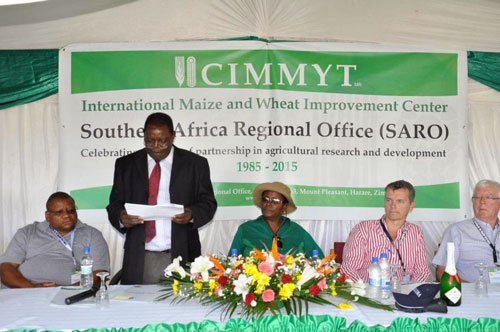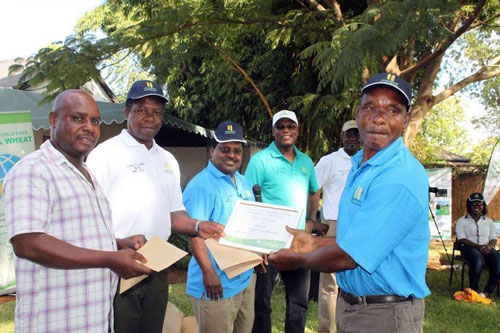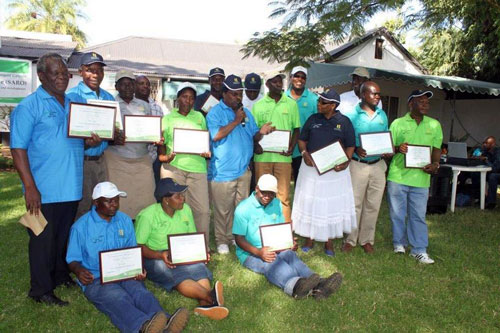
On March 18, CIMMYT Southern Africa Regional Office (SARO) celebrated 30 years of agricultural research and development.
The colourful ceremony, held amid pomp and fanfare, was attended by more than 300 people representing donors, non-governmental organizations, research institutions, Zimbabwe government departments, seed companies and farmer associations. The celebration included an on-station tour, with CIMMYT–SARO showcasing its work.
CIMMYT–SARO has been operating in Zimbabwe since March 1985 with the support of the government of Zimbabwe, and other public and private-sector partners, including the University of Zimbabwe and the Department of Research and Specialist Services. In Zimbabwe, CIMMYT conducts experiments at its main station, as well as at Muzarabani and Chiredzi sub- stations. There are also on-farm trials across the country.
Officially commemorating CIMMYT–SARO’s 30-year anniversary (SARO@30), Zimbabwe’s Minister of Agriculture, Mechanisation and Irrigation Development, Dr. Joseph Made, said, ‘’The regional office has been focusing on developing new maize varieties adapted to smallholder farmers in Zimbabwe and the mid-altitude agroecologies in sub-Saharan Africa. Since then, the office has expanded to include development of research technologies for conservation-agriculture systems, sustainable intensification of production of smallholder farms and postharvest research activities.”
Stay on course, but also look beyond yield
In a speech read on his behalf by Mr. Ringson Chitsiko, the Ministry’s Permanent Secretary, Made applauded CIMMYT’s research work on developing a stock of maize since this was a major staple in the country, and beyond. Although CIMMYT and its partners had introduced various technologies for increasing yields, the Center had to develop more technologies to mitigate the effects of climate change and other challenges.
The minister advised: “CIMMYT needs to work harder and be alert, especially in the face of the ever-growing population, climate change and variability, and new threats through maize diseases and pests. I urge CIMMYT to continue pursuing its mandate for the benefit of the Southern African region.”
In support of this goal and in recognition of CIMMYT’s sustained presence and commitment to the SADC region and Zimbabwe, the Zimbabwe government in 2012 renewed the Host Country Agreement, according CIMMYT–SARO diplomatic status. ‘’We are jointly working towards signing a new collaborative agreement to strengthen maize research to combat a new threat in the form of maize lethal necrosis [MLN] disease recently discovered in East Africa and which has a potential to wipe out an entire maize crop if it spreads to Southern Africa,’’ Made said.
MLN caused 100 percent crop loss for some Kenyan farmers between 2011 and 2012, and cases were also reported in Uganda and Tanzania.
Speaking at the same occasion, Dr. Olaf Erenstein, Director of CIMMYT’s Socioeconomics Program who represented Dr. Thomas Lumpkin, CIMMYT Director General, said CIMMYT, since its establishment in Mexico in 1966 currently has 13 representative offices around the world. Its mandate and mission is to sustainably increase the productivity of maize and wheat systems to ensure global food security and reduce poverty. The regional office, he said, is serving its purpose in contributing to increasing food security.

‘Easy Friday’: Reflect, Celebrate, Play, Plan for The Future
As part of the continued celebrations, March 27 was ‘Easy Friday: CIMMYT–SARO hosted a luncheon and sports day for its staff. Thirteen long-serving employees who served for between 15 and 29 years were honored for their commitment. The employees were from administration, finance, Global Maize Program and Conservation Agriculture Program.
Sixty-two year-old Mr. John Chifamba, a recorder who has worked for CIMMYT for 29 years, said, “CIMMYT is my home. I have gained considerable on-the-job experience in maize research. “Any plans of leaving CIMMYT?” To this, Chifamba said an emphatic no. “Very soon, it will be retirement time and I will find a plot to utilize the good agricultural practices I have seen and learned at CIMMYT.“
Joining hands: From Zambia to Afghanistan
Mekuria continued: ‘’Our partnership approach will give us more capacity to meet with our constituents at the highest level, strengthening our relationships with governments as they formulate the most effective agricultural policies for the good of their people and natural resources.”

CIMMYT–SARO is part of the world’s largest public drought and low nitrogen stress research network. Every year 500,000 envelopes of maize seeds are sent to over 70 institutions worldwide. The demand for CIMMYT–SARO maize germplasm extends from Zambia to Afghanistan.
During the past 10 years, sustainable intensification strategies based on the principles of conservation agriculture (CA) have been successfully promoted in Malawi, Mozambique, Zambia and Zimbabwe. Making use of the combined benefits of minimum soil disturbance, crop residue retention and crop rotation, CA increases yields when compared to conventional agricultural practices after two to five cropping seasons. Trials on farmers’ fields in Malawi, for example, increased yields by 20 to 60 percent. In Zambia and Zimbabwe, yields were increased by almost 60 percent using animal traction CA technologies.
Major highlights during the 30 years existence of CIMMYT in Zimbabwe include the development and release of more than 50 maize hybrids and open pollinated varieties (OPVs) adapted to drought-prone regions. These new varieties are expected to benefit almost 12 million people, helping to enhance food security, increase livelihoods and reduce poverty in Southern Africa.
CIMMYT’s seed system activities and support in training and technical assistance have led to the emergence of smaller domestic seed companies in the various Southern African countries. Farmers’ access to seed has improved. In addition, the Center has trained more than 200 technicians and graduate students through short- and long-term training in their various disciplines. Nearly 30 percent of these trainees are women. Trainees are drawn from southern Africa, the rest of Africa, and beyond.
 Nutrition, health and food security
Nutrition, health and food security 
